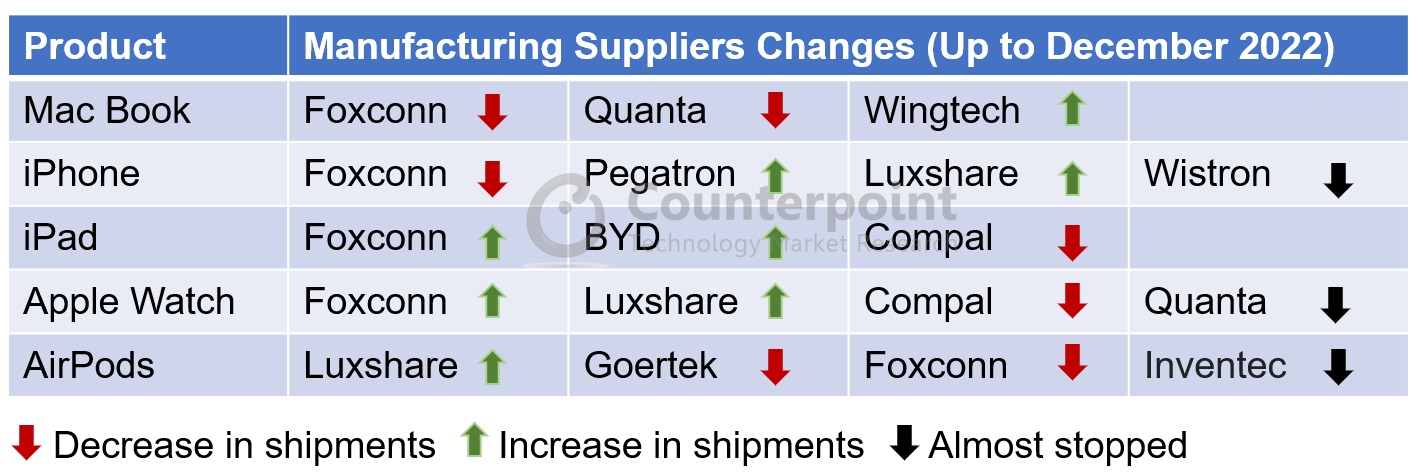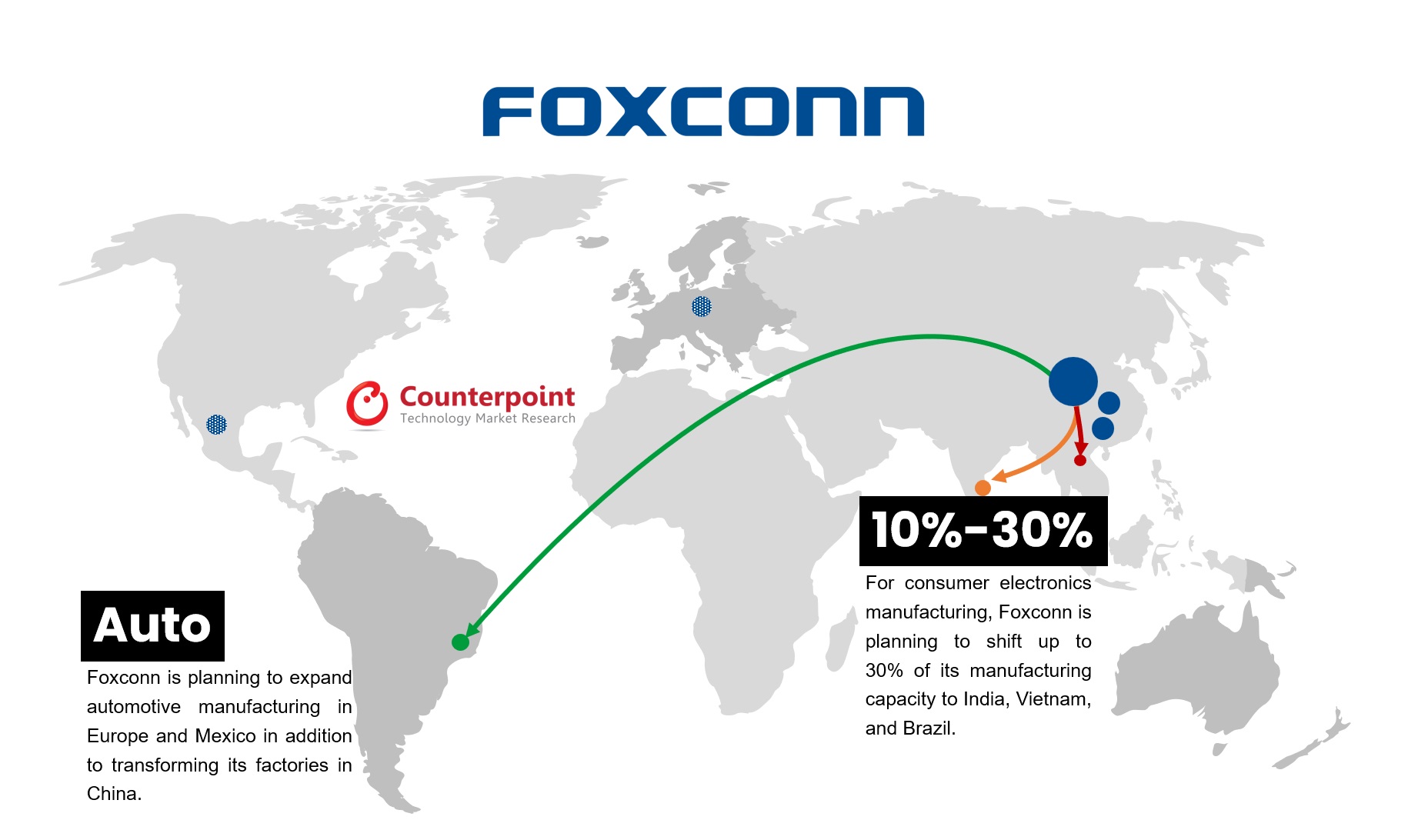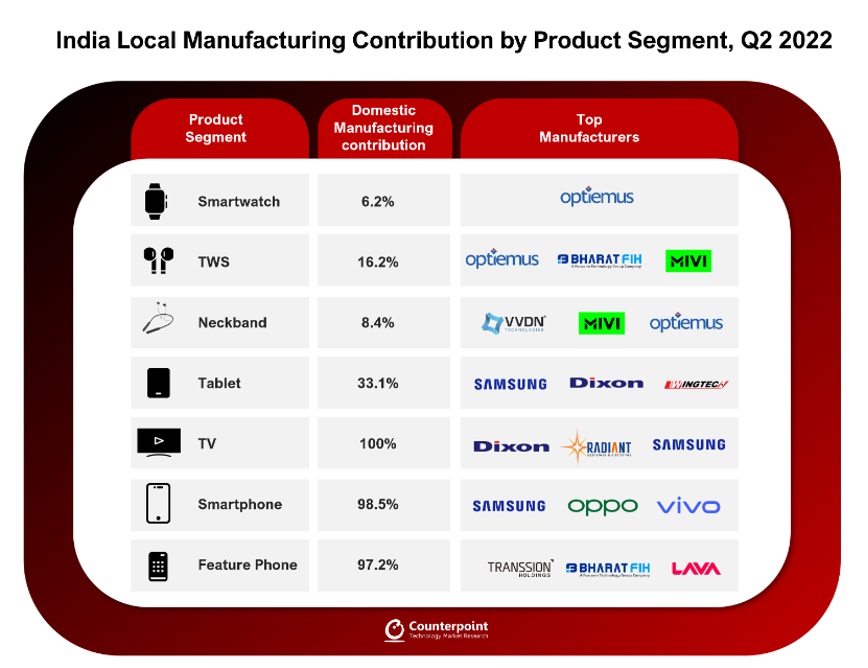- Zhengzhou Foxconn is gradually restoring production after COVID-triggered disruptions. The iPhone 14 Pro series is still facing long wait times.
- Apple started its manufacturing diversification before COVID-19.
- Supply chain vendors are expanding production sites to optimize cost and shipment benefits.
- Key manufacturing enterprises are accelerating their global diversification to take advantage of incentive policies from different regions.
Apple Manufacturing Suppliers Changes

Source: Counterpoint Manufacturing Research
Manufacturing shift
Against this backdrop, the global manufacturing industry chain is steadily shifting outside China to avoid the risk of relying on a single manufacturing base. As the main iPhone manufacturer, Foxconn is planning to shift up to 30% of its capacity to India, Vietnam and Brazil. Besides, the company is planning to expand automotive manufacturing in Europe and Mexico. Foxconn, which is the world’s biggest EMS (electronics manufacturing services) provider, had already developed rather high production capacities in India and Vietnam before the recent disruption at its Zhengzhou plant. It has no intention of expanding its capacity further. Now, the challenge for Foxconn is how to better utilize its current capacity and balance the cost and risks.

Source: Counterpoint Manufacturing Research
Vietnam, India emerging as manufacturing centers
Vietnam and India are emerging as smart device manufacturing centers. Vietnam has benefited a lot in manufacturing by attracting foreign investments. As of September 2022, there were 21 Apple suppliers in Vietnam. Although Vietnam’s labor costs are lower than in China and its population is younger than China’s, the limiting factor for Vietnam’s manufacturing development is its population size. When establishing their manufacturing facility in a country, the manufacturers and component suppliers also consider the local demand. Vietnam’s population in 2021 was around 98 million, less than 8% of China’s.
India has almost the same population size as China’s, and a higher birth rate. Therefore, many local and international consumer electronics brands regard India as an important strategic market. Besides, with the continuous improvement and maturing of production technology combined with the government’s support policies, many smart hardware products and components have gradually landed in India’s local production. According to Counterpoint’s Made in India research, smartphones manufactured in India grew 16% YoY in Q2 2022 (April-June) to reach over 44 million units.

Source: Counterpoint Made in India Research, Q2 2022
Can India replace China as a manufacturing base?
Most supply chain vendors bear high operational costs, especially their production lines. They have to consider the market scale, sustainability of the income revenue, local infrastructure stage, local policies and incentive schemes, and environment for foreign investments. It will be difficult for India to replace China as a manufacturing center in the short term. Infrastructure, logistics, and upstream and downstream industrial chains are the limiting factors here. However, thanks to the Production-Linked Incentive (PLI) scheme, several manufacturing companies have expanded their investments in India, driving the country’s manufacturing industry development. India’s department of telecommunications has extended the scheme for telecom by one year and offered an incentive package for 4%-7% of sales over five years. The scheme requires an investment threshold of INR 100 million ($1.2 million) for micro, small and medium enterprises (MSMEs) and INR 10 billion ($120 million) for non-MSMEs, excluding land and building costs. Led by Foxconn and Pegatron, companies have already invested in factories, production lines, relatively advanced manufacturing processes, and personnel training in India.
Apple works to optimize, modularize production
Apple has continued to optimize and improve product design this year with a focus on production modularization and ease of maintenance. The iPhone14 and iPhone14 Plus reflect this effort, with the difficulty of production reducing significantly. Now, new product introduction (NPI) can be carried out faster from overseas factories than before. Now it is possible for the plants in India to produce the iPhone 14 almost simultaneously with the plants in China.
Local production in other countries
Meanwhile, local production will continue to grow in countries like Indonesia and Brazil. For example, leading smartphone and PC OEMs have built local factories for local demand or assigned local production to their manufacturing partners like Flex, Foxconn and Pegatron. The high tariff on finished goods imports is the key driver. However, with demand growth and higher value shift, the local production capability becomes an advantage for these OEMs. Mexico will benefit from this trend due to its geographical location near the US. Smart device and electric vehicle manufacturing can be the next wave in Mexico.
China enterprises’ stance
Many of China’s manufacturing enterprises are investing in overseas diversification to benefit from local policies, even though China has a more comprehensive industrial chain. Top smartphone ODMs like Huaqin, Wingtech and Longcheer have already established factories in India and Southeast Asia. Smart wearable device manufacturers such as Goertek, AAC, Luxshare, Cosonic and Yingtong have also set up manufacturing centers in Southeast Asia to keep closer contact with their clients.
Whether to reduce risks, take advantage of lower labor costs, or benefit from incentives, the diversification of global manufacturing from China is steadily underway.
Feel free to contact us at press@counterpointresearch.com for questions regarding our in-depth research and insights.
You can also visit our Data Section (updated quarterly) to view the smartphone market share for World, USA, China and India.
Related Posts

